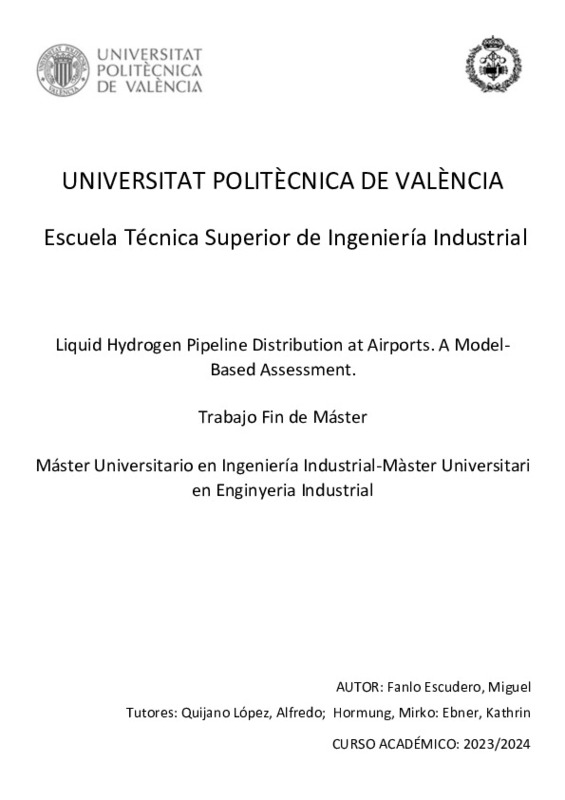|
Resumen:
|
[ES] El sector de la aviación se enfrenta al ambicioso objetivo de lograr su descarbonización para el año 2050. El hidrógeno líquido se presenta como uno de los combustibles alternativos más atractivos para alcanzar esta ...[+]
[ES] El sector de la aviación se enfrenta al ambicioso objetivo de lograr su descarbonización para el año 2050. El hidrógeno líquido se presenta como uno de los combustibles alternativos más atractivos para alcanzar esta meta gracias a su alta densidad gravimétrica y la ausencia de emisiones de carbono directas durante su combustión. No obstante, para conseguir la implantación del hidrógeno líquido como combustible se requiere una profunda transformación del sector de la aviación, de sus infraestructuras y prácticas. Por ello, este TFM aborda el estudio de la distribución del hidrógeno líquido en los aeropuertos. Se valoran distintas opciones de distribución, pero se estudia con especial dedicación la distribución por tubería y uno de sus principales problemas asociados, el cálculo de las pérdidas por ebullición, en inglés "boil-off losses". En el trabajo se desarrolla un modelo de progamación que logra optimizar el sistema de distribución de hidrógeno, de acuerdo con la configuración del aeropuerto, y reducir al mínimo las pérdidas de combustible. Se concluye con una comparación de las pérdidas por ebullición entre distintas configuraciones que permite cuantificar el impacto que factores como el caudal másico, el diámetro de las tuberías y su longitud suponen sobre el método de distribución de hidrógeno líquido.
[-]
[EN] In the face of growing energy demand and the need to reduce greenhouse gases, green
hydrogen represents an attractive energy vector that can decarbonize highly energy demanding sectors, such as aviation. In particular, ...[+]
[EN] In the face of growing energy demand and the need to reduce greenhouse gases, green
hydrogen represents an attractive energy vector that can decarbonize highly energy demanding sectors, such as aviation. In particular, liquid hydrogen, due to its higher
energy density per unit volume compared to its gaseous state, is expected to
progressively replace traditional fuels in aviation. To make hydrogen-based aviation a
reality, the aviation sector must undergo a major transformation from fully developing the
hydrogen supply chain to redesigning existing aircraft and airport infrastructures. Due to
the characteristics of liquid hydrogen, whose boiling point is -253°C, highly insulated
technology must be developed along the supply chain to prevent boil-off. Boil-off is the
vaporization of the fuel due to unavoidable heat input and represents a challenge as it
can significantly impact on the overall efficiency of the LH2 supply chain.
This thesis provides preliminary knowledge on the distribution of liquid hydrogen by
pipeline at the airport. The boundaries of the study include the distribution of hydrogen
from the airport storage farm to each aircraft stand. The study focuses only on fuel
transfer, excluding subsequent refueling. To do this a generic airport is defined taking
into account expected performance parameters and characteristics of each of the main
components of the pipeline distribution system. The work focuses on quantifying the
volume of boil-off gases occurring along the distribution pipeline under base case
operating conditions and employs this parameter for a comparative assessment. Next, a
series of parametric analyses are performed in which the impact of several parameters
on the boil-off are evaluated and the results are compared with the base case.
This thesis, although a preliminary study, can serve as a simplified model to compare
different configurations and assist in infrastructure design decisions. In addition, the work
highlights the need for further research and development of technologies and equipment
to be able to implement hydrogen in aviation
[-]
|







